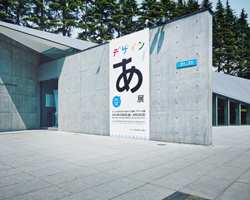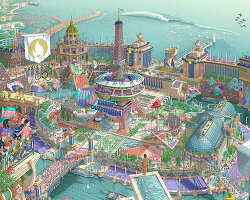we spoke to graphic designer ryo ueda, founder of the sapporo-based studio commune, which specializes in creating brand identities.
DB: please could you tell us briefly about the evolution of your work?
RU: I was born [1977] in shigaraki a town famous for its ceramic art that is located close to the tea producing area of kyoto, uji. my father and my grandfather are from a long line of potters and they exposed me to painting and making things from an early age and I became quite good at those things. but instead of liking the actual activities, I think what I liked most was surprising and delighting people.
I had many interests growing up and when it was time to start university, I really couldn’t decide what to study. in the end, I entered the department of international culture at the university of sapporo, and moved to that town. during my college days, I spent two short term study periods in sweden and I feel a connection to sweden – until this day. after finishing my cultural studies all I wanted to do was design, and so I enrolled at the design school in sapporo. my experiences studying design were very precious, they broadened my outlook on life and it felt like I had finally returned to the path I was destined for.
after graduating, I gained experience as a designer at a design studio. it was only a small place but they produced some very good work and I learned a lot from it. shortly after, I started commune – working as an independent freelancer.

ribbonesia identity and applications



DB: what made you expand commune into a studio?
RU: designing is my work, and creating something for someone still brings me the same happiness it did when I was a child. I wanted to work in a team so I could share that joy with someone. also, problem solving as part of a group is even more fun. and of course on a practical level some projects simply cannot be fulfilled by one person alone. to go further into this topic, I believe that design is something that always changes with the times, and there is a need for new information and for people who gather it. people grow old. while experience and knowledge are important, so are youthful, fresh ideas. and ideas are things that grow better under the influence of many people rather than just one. our designs are created through a combination of brainstorming and communication.
DB: how do you share / divide your workload between studio members?
RU: I am in charge of the design, art direction and management. as many of the staff as possible participate in the initial thought process – because I think that discussions between many people are better for the development of ideas. we carry out the design work as a team together with professionals from outside the company, like photographers, copywriters, interior designers, web page developers, printing directors and so on.

reason identity

inadagumi theatrical company identity
DB: how would you describe your work to someone who hasn’t seen it before?
RU: the scope of our work is very broad so it is difficult to describe it in a few words. if I were to attempt to, I would say that it consists in solving problems and by raising the value of the project and the client. we aim to move peoples’ hearts a bit, and generate emotions and empathy with our solutions.
DB: how did you come to work on the type of projects you do now?
RU: our work is wide-ranging and our projects are holistic from graphics to web, products, packaging, interiors, and so on. if there is anything that is needed to reach a goals we will accept the challenge. we never refuse a request, thinking that we can’t do something because we haven’t done it before. in visual communication especially it is very important to conceive and create the design cohesively – using one set of criteria. working in that way, our areas of work and range of clients have continued to broaden.

ritaru coffee identity and applications

DB: what attracted you to designing brand identities?
RU: the brand identity is a reflection of the concept of the enterprise or brand. therefore, the design of a brand identity starts with the profound knowledge of the enterprise or brand. this is something very informative. and also, I get the feeling that I become very close to the client, that I raise the worth of the enterprise or brand through the accurate design of their identity, and that this leads to people becoming interested. all of that makes me very happy.
DB: who would your ideal client be?
RU: a person that likes his own brand and the products and services associated with it, and that has created something he can be proud of, without lies or exaggerations. in that sense I have been blessed with ideal clients already.

yuko ono sthlm (japanese tea) identity and applications


DB: what mistakes or ‘traps’ should a young designer avoid when working on an identity system?
RU: nowadays anyone can make designs. and the trend is to think that simple things are good. however, a design is not good just because it is simple, but it can become simple by searching for the essence of of what you need to communicate. kenya hara, a designer I respect very much, said ‘a design’s quality is determined by the amount of thinking’. good identities might look simple on the surface, but are often the result of deep thinking. to err here and just create a simple things for the sake of it is very dangerous. because a superficial, simple design becomes immediately obsolete.
DB: do you think it’s important for a graphic designer to be able to draw?
RU: yes – in the sense that one can is then able to reproduce immediately the image one has in one’s mind, I think it is convenient to be able to draw a rough sketch. but there are some cases in which a design is completed without even touching a pencil. for the sake of embodying an idea, it is better if people use as much as possible sensible and easy to use tools. but, as long as one is good at handling a mouse or a digital tablet, or other similar tools, a traditional pen or pencil is not always necessary. and furthermore the new generation might invent new methods.

hitohari scrap and craftmanship (clothing and apparel) identity and applications



DB: how do you think online design resources have influenced the design being produced today?
RU: finding answers any time by searching the internet is convenient, isn’t it? but it is scary, as it destroys the habit of thinking. as I just mentioned in my previous answer, you might conclude that the possibilities of thinking of something different will become lower. first think for yourself, and then, if there is something you don’t understand, investigate. this might be the better way, no? the designers of today should keep in mind the need to spend the time they are not at the computer consciously acquiring many real life experiences.

this cigarettes

DB: besides design, what are you passionate about and why?
RU: mountain climbing and camping. getting in contact with nature reminds me of feelings I tend to forget in my designer life, spent mostly in front of a computer. it allows me to reconnect with myself. furthermore, the town of sapporo, where I live, is the closest to great nature in japan, and not to enjoy it would be a sacrilege.

self promotional posters
DB: do you have any superstitious beliefs?
RU: not really but to me intuition is very important. my meetings with people and the small things I feel in my heart. decisions made based on my intuition give often better results than those based on hard thinking.

exhibition posters
DB: what do you want to do in 2014 that you have never done before?
RU: I would like to establish commune as a new type of organization. up until now it has been a design practice – working with clients in the ways I have talked about. in the near future the plan is to expand commune to incorporate a shop and event space filled with things we design and love – so that we can meet, and connect with more people through conferences, study groups and workshops, and hopefully as a result new projects will be born.
graphic studio interviews (193)
logo design (246)
posters (78)
PRODUCT LIBRARY
a diverse digital database that acts as a valuable guide in gaining insight and information about a product directly from the manufacturer, and serves as a rich reference point in developing a project or scheme.


















